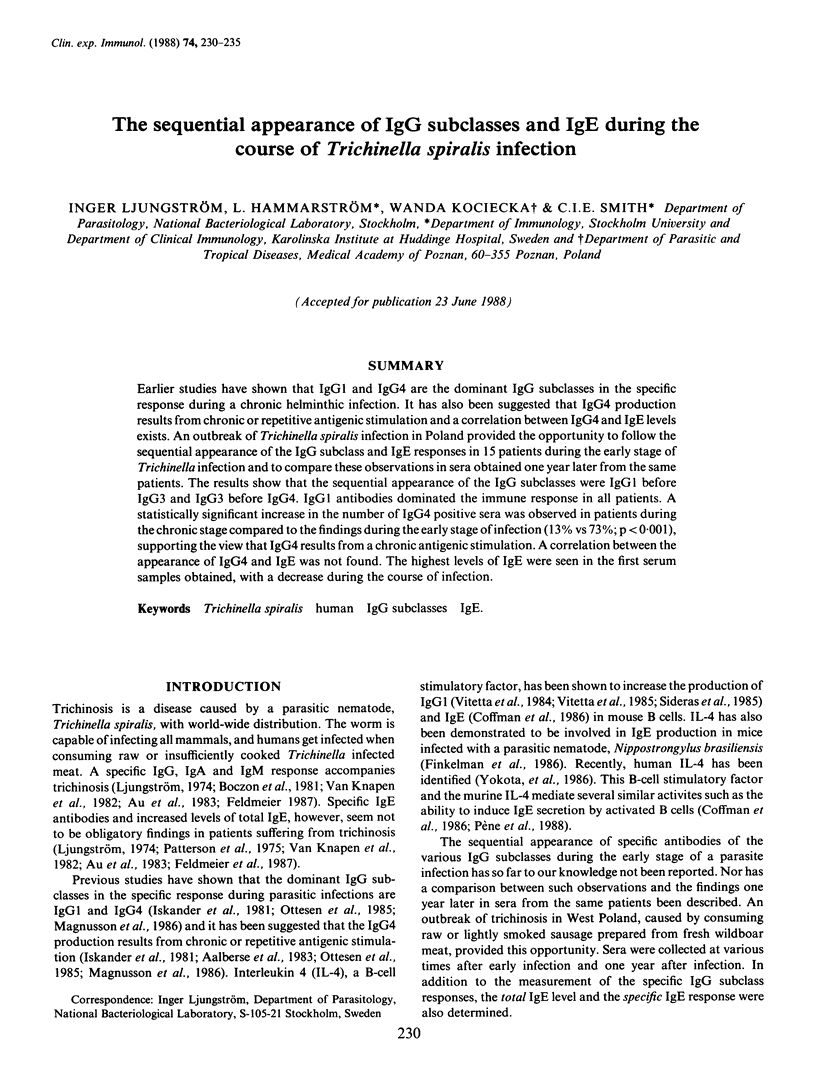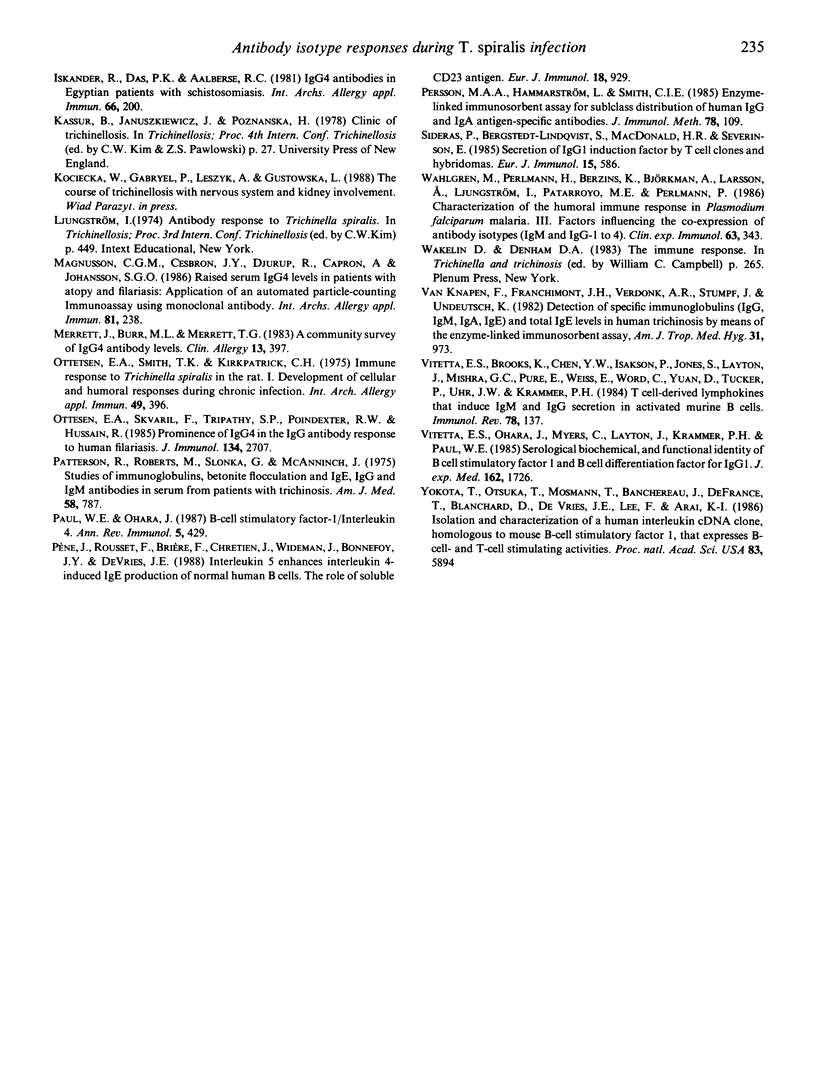Abstract
Earlier studies have shown that IgG1 and IgG4 are the dominant IgG subclasses in the specific response during a chronic helminthic infection. It has also been suggested that IgG4 production results from chronic or repetitive antigenic stimulation and a correlation between IgG4 and IgE levels exists. An outbreak of Trichinella spiralis infection in Poland provided the opportunity to follow the sequential appearance of the IgG subclass and IgE responses in 15 patients during the early stage of Trichinella infection and to compare these observations in sera obtained one year later from the same patients. The results show that the sequential appearance of the IgG subclasses were IgG1 before IgG3 and IgG3 before IgG4. IgG1 antibodies dominated the immune response in all patients. A statistically significant increase in the number of IgG4 positive sera was observed in patients during the chronic stage compared to the findings during the early stage of infection (13% vs 73%; p less than 0.001), supporting the view that IgG4 results from a chronic antigenic stimulation. A correlation between the appearance of IgG4 and IgE was not found. The highest levels of IgE were seen in the first serum samples obtained, with a decrease during the course of infection.
Full text
PDF





Selected References
These references are in PubMed. This may not be the complete list of references from this article.
- Aalberse R. C., van der Gaag R., van Leeuwen J. Serologic aspects of IgG4 antibodies. I. Prolonged immunization results in an IgG4-restricted response. J Immunol. 1983 Feb;130(2):722–726. [PubMed] [Google Scholar]
- Au A. C., Ko R. C., Simon J. W., Ridell N. J., Wong F. W., Templer M. J. Study of acute trichinosis in Ghurkas: specificity and sensitivity of enzyme-linked immunosorbent assays for IgM and IgE antibodies to Trichinella larval antigens in diagnosis. Trans R Soc Trop Med Hyg. 1983;77(3):412–415. doi: 10.1016/0035-9203(83)90175-x. [DOI] [PubMed] [Google Scholar]
- Coffman R. L., Ohara J., Bond M. W., Carty J., Zlotnik A., Paul W. E. B cell stimulatory factor-1 enhances the IgE response of lipopolysaccharide-activated B cells. J Immunol. 1986 Jun 15;136(12):4538–4541. [PubMed] [Google Scholar]
- Feldmeier H., Fischer H., Blaumeiser G. Kinetics of humoral response during the acute and the convalescent phase of human trichinosis. Zentralbl Bakteriol Mikrobiol Hyg A. 1987 Apr;264(1-2):221–234. doi: 10.1016/s0176-6724(87)80143-8. [DOI] [PubMed] [Google Scholar]
- Finkelman F. D., Katona I. M., Urban J. F., Jr, Snapper C. M., Ohara J., Paul W. E. Suppression of in vivo polyclonal IgE responses by monoclonal antibody to the lymphokine B-cell stimulatory factor 1. Proc Natl Acad Sci U S A. 1986 Dec;83(24):9675–9678. doi: 10.1073/pnas.83.24.9675. [DOI] [PMC free article] [PubMed] [Google Scholar]
- Flanagan J. G., Rabbitts T. H. Arrangement of human immunoglobulin heavy chain constant region genes implies evolutionary duplication of a segment containing gamma, epsilon and alpha genes. Nature. 1982 Dec 23;300(5894):709–713. doi: 10.1038/300709a0. [DOI] [PubMed] [Google Scholar]
- Iskander R., Das P. K., Aalberse R. C. IgG4 antibodies in Egyptian patients with schistosomiasis. Int Arch Allergy Appl Immunol. 1981;66(2):200–207. doi: 10.1159/000232819. [DOI] [PubMed] [Google Scholar]
- Magnusson C. G., Cesbron J. Y., Djurup R., Capron A., Johansson S. G. Raised serum IgG4 levels in patients with atopy and filariasis: application of an automated particle-counting immunoassay using monoclonal antibody. Int Arch Allergy Appl Immunol. 1986;81(3):238–244. doi: 10.1159/000234141. [DOI] [PubMed] [Google Scholar]
- Merrett J., Burr M. L., Merrett T. G. A community survey of IgG4 antibody levels. Clin Allergy. 1983 Sep;13(5):397–407. doi: 10.1111/j.1365-2222.1983.tb02615.x. [DOI] [PubMed] [Google Scholar]
- Ottesen E. A., Skvaril F., Tripathy S. P., Poindexter R. W., Hussain R. Prominence of IgG4 in the IgG antibody response to human filariasis. J Immunol. 1985 Apr;134(4):2707–2712. [PubMed] [Google Scholar]
- Ottesen E. A., Smith T. K., Kirkpatrick C. H. Immune response to Trichinella spiralis in the rat. I. Development of cellular and humoral responses during chronic infection. Int Arch Allergy Appl Immunol. 1975;49(3):396–410. [PubMed] [Google Scholar]
- Patterson R., Roberts M., Slonka G., McAninch J. Studies of immunoglobulins, bentonite flocculation and IgE, IgG and IgM antibodies in serum from patients with trichinosis. Am J Med. 1975 Jun;58(6):787–793. doi: 10.1016/0002-9343(75)90633-6. [DOI] [PubMed] [Google Scholar]
- Paul W. E., Ohara J. B-cell stimulatory factor-1/interleukin 4. Annu Rev Immunol. 1987;5:429–459. doi: 10.1146/annurev.iy.05.040187.002241. [DOI] [PubMed] [Google Scholar]
- Persson M. A., Hammarström L., Smith C. I. Enzyme-linked immunosorbent assay for subclass distribution of human IgG and IgA antigen-specific antibodies. J Immunol Methods. 1985 Apr 8;78(1):109–121. doi: 10.1016/0022-1759(85)90334-5. [DOI] [PubMed] [Google Scholar]
- Pène J., Rousset F., Brière F., Chrétien I., Wideman J., Bonnefoy J. Y., De Vries J. E. Interleukin 5 enhances interleukin 4-induced IgE production by normal human B cells. The role of soluble CD23 antigen. Eur J Immunol. 1988 Jun;18(6):929–935. doi: 10.1002/eji.1830180615. [DOI] [PubMed] [Google Scholar]
- Sideras P., Bergstedt-Lindqvist S., MacDonald H. R., Severinson E. Secretion of IgG1 induction factor by T cell clones and hybridomas. Eur J Immunol. 1985 Jun;15(6):586–593. doi: 10.1002/eji.1830150611. [DOI] [PubMed] [Google Scholar]
- Vitetta E. S., Brooks K., Chen Y. W., Isakson P., Jones S., Layton J., Mishra G. C., Pure E., Weiss E., Word C. T-cell-derived lymphokines that induce IgM and IgG secretion in activated murine B cells. Immunol Rev. 1984 Apr;78:137–157. doi: 10.1111/j.1600-065x.1984.tb00480.x. [DOI] [PubMed] [Google Scholar]
- Vitetta E. S., Ohara J., Myers C. D., Layton J. E., Krammer P. H., Paul W. E. Serological, biochemical, and functional identity of B cell-stimulatory factor 1 and B cell differentiation factor for IgG1. J Exp Med. 1985 Nov 1;162(5):1726–1731. doi: 10.1084/jem.162.5.1726. [DOI] [PMC free article] [PubMed] [Google Scholar]
- Wahlgren M., Perlmann H., Berzins K., Björkman A., Larsson A., Ljungström I., Patarroy M. E., Perlmann P. Characterization of the humoral immune response in Plasmodium falciparum malaria. III. Factors influencing the coexpression of antibody isotypes (IgM and IgG-1 to 4). Clin Exp Immunol. 1986 Feb;63(2):343–353. [PMC free article] [PubMed] [Google Scholar]
- Yokota T., Otsuka T., Mosmann T., Banchereau J., DeFrance T., Blanchard D., De Vries J. E., Lee F., Arai K. Isolation and characterization of a human interleukin cDNA clone, homologous to mouse B-cell stimulatory factor 1, that expresses B-cell- and T-cell-stimulating activities. Proc Natl Acad Sci U S A. 1986 Aug;83(16):5894–5898. doi: 10.1073/pnas.83.16.5894. [DOI] [PMC free article] [PubMed] [Google Scholar]
- van Knapen F., Franchimont J. H., Verdonk A. R., Stumpf J., Undeutsch K. Detection of specific immunoglobulins (IgG, IgM, IgA, IgE) and total IgE levels in human trichinosis by means of the enzyme-linked immunosorbent assay (ELISA). Am J Trop Med Hyg. 1982 Sep;31(5):973–976. doi: 10.4269/ajtmh.1982.31.973. [DOI] [PubMed] [Google Scholar]


